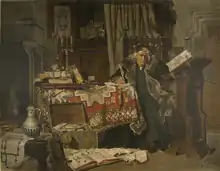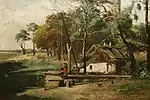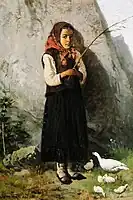Antoni Gramatyka | |
|---|---|
.jpg.webp) | |
| Born | Antoni Gramatyka 1841 Kalwaria Zebrzydowska, Poland |
| Died | 23 May 1922 Kraków, Poland |
| Nationality | |
| Known for | Painting |
| Movement | Realism |
Antoni Gramatyka (1841 in Kalwaria Zebrzydowska – December 23, 1922 in Kraków) was a Polish painter, associated Kraków and its surroundings.[1]
Biography
Antoni Gramatyka began his studies at the Kraków Jan Matejko Academy of Fine Arts in 1870, where he was taught by Władysław Łuszczkiewicz and Jan Matejko. After their completion, he continued to study at the Academy of Fine Arts in Vienna, under Christian Ruben and Joseph von Führich. After returning from Vienna, Gramatyka continued his studies at the Jan Metjko Academy of Fine Arts in Kraków. Together with the Kraków Society of Friends of Fine Arts, he exhibited his works in Kraków and Lwów. As a Realist, he presented day-to-day life of the locals in Kraków and surrounding villages. He painted landscape paintings of Kalwaria Zebrzydowska, Żywiecczyzna, Podhale, Spisz and the areas surrounding Kraków. Apart from landscapes, Gramatyka also painted portraits and church polychromes, inter alia in the Płock Cathedral.[2] He worked on renovation and conservation projects, inter alia in Queen Sophia's Chapel on the Wawel and St. Mary's Basilica in Kraków.[3]
Gallery
 Jan Długosz
Jan Długosz
(1878) Landscape
Landscape
(1880) Village landscape
Village landscape
(1880) Goosewoman
Goosewoman
(1881)
References
- ↑ SA, Agra-Art. "Gramatyka Antoni - malarz, Polska, baza artystów Agra-Art". www.agraart.pl (in Polish). Archived from the original on 2 August 2017. Retrieved 30 August 2017.
- ↑ "Wiadomości Krakowskie. 1922, nr 61 (30 XII)". Małopolska. 1922. Retrieved 30 August 2017.
- ↑ "Aukcja katalogowa, Aukcja Malarstwa, Antoni GRAMATYKA, Tatry". Artinfo (in Polish). Retrieved 30 August 2017.